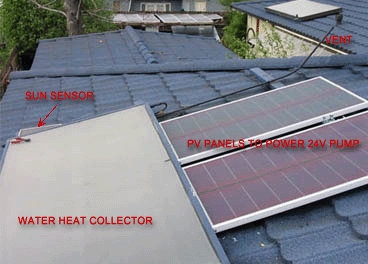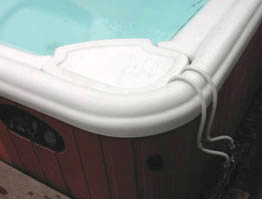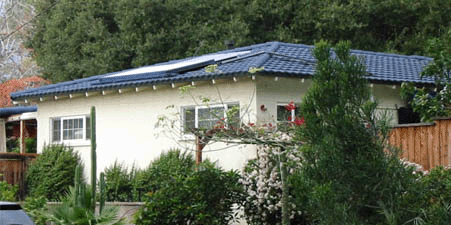

 The water heat collector that's hooked up to the hot tub is the 4- by 8-foot rectangular unit labelled in the lower left of this image.
The water heat collector that's hooked up to the hot tub is the 4- by 8-foot rectangular unit labelled in the lower left of this image.
Above it, two 64-Watt photovoltaic (PV) collectors are wired in series to supply power for the 24-Volt DC pump that circulates water directly between the hot tub and the water heat collector. A sun-sensor visible mid-left tells the regulator when to turn the pump on and off. The vent is a 1/2-inch copper pipe rising a few feet above the level of the top of the solar collector. It defines the system as an open-loop drainback arrangement.
That means when the pump wakes up in the morning and starts running, it pulls water from the hot tub, lifts it up to the bottom of the collector, and fills it up. The water then spills down from the top of the collector, returning to warm the hot tub. Usually the water boils for a few seconds when it initially reaches the collector, and some steam and liquid water can be seen venting. Then it just continues to circulate, and the tub water heats up. When the pump shuts down, all the water drains back to the tub, so there are no worries about water changing state while it's in the system.
The pipes are all soldered copper, foam-insulated within a steel box-conduit. Everything fastened to the roof was done so with the fiercest northwest Santa Ana (canyon foehn) winds in mind. (When 80-MPH gusts prevailed for two days and nights early in January '03, everything passed the Santa Ana test.)
The solar electric system PV panels had not been installed on the roof when the above photo was taken.
The image below shows how the solar system interfaces with the hot tub. Two flexible connectors, the type that are normally used to connect a faucet, sneak into the tub in the corner chamber where the filters reside. They screw onto a little, perforated PVC pipe assembly that dangles freely inside the chamber. From there, the hot tub's own circulation system (a 7W pump) filters and distributes the solar-heated water. The only modification I made to the tub was to place two small notches in the flange that supports the corner compartment cover. The cover fits the corner a little more snugly now.

As mentioned before, the main drive was to get rid of the 1,500-Watt electrical drain pulled by the hot tub's built-in heater system. Now it remains set so it would come on only if the water were to cool to 85 degrees F. In mid-January, the solar water heating system brings it up to 106 degrees, which cools off to 104 by morning. I expect the electric heater will rarely run anymore!
The two water-heat collectors came with the house. They were installed on the garage roof (near where the single panel is now, in the upper right of the first image), but they had been disconnected and were not functional. I removed and stored them when the new metal roof went on a couple years ago. They're similar in design to Gobi collectors, but they're some different brand. No matter, they tested out ok when I had them on the ground. I wanted to be sure they had no leaks, and maybe measure their effectiveness. I was reading a book while one remained full of water under pressure from the garden hose, in full sunlight. Suddenly, the hose connector exploded off, and boiling water and steam spewed out a geyser for ten minutes, completely emptying the sizzling panel. I guessed it was water tight enough. And efficient enough to work with the hot tub; no further measurements would be needed!

The view from ground-level: the whole thing isn't too much of an eyesore. The plumbing feeds through the roof and comes down inside a PVC box-conduit that looks like a rain spout (that's what it used to be) barely visible between trees on the right. All the plumbing is foam-insulated, and the pump lives in a weatherproof and sound-insulated cover. Electronics (the regulator, resistor, and Sun-sensor relay circuit) are mounted on the PVC plumbing conduit just under the eaves. The hot tub sits just inside the fence there, up against the house. |
In mid January, the pump comes on about 9:30 AM, and runs solidly until it cuts off around 3 PM. This is enough to keep the tub water between 106 and 103 degrees F. If it can do this at the low Sun elevations during January, I'm confident it will continue to work nicely during most of the year. (Note added a year later: it sure does.)
Some day, maybe I'll route the plumbing under the roof, through the attic space, instead of keeping it draped over the hip of the roof. Also some day I'll hook up that other water-heat collector panel to the house hot-water system and reduce consumption of natural gas. But it's good to have finally gotten rid of that 1,500 Watt electrical load for most of the time, freeing up the solar electric system for better applications than heating water. Now the electric meter will spend more of its time running backward!
Written January 19, 2003
Updated February 15, 2009